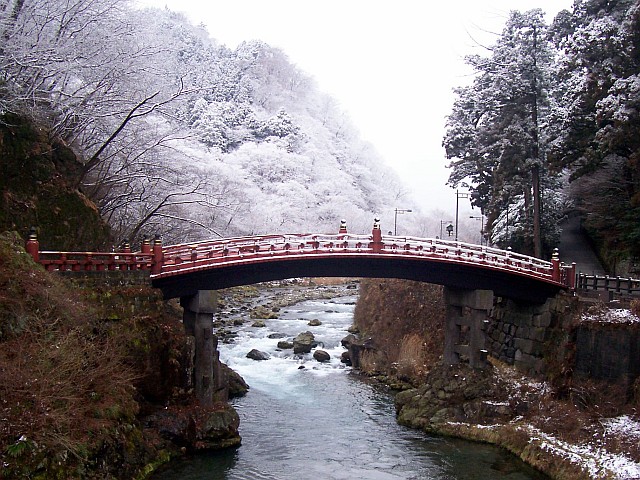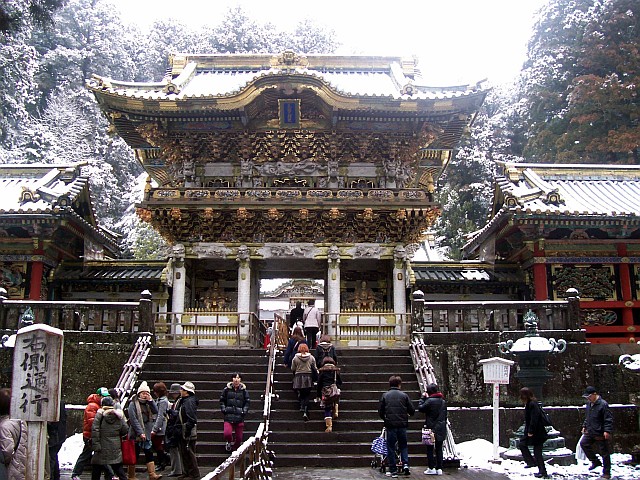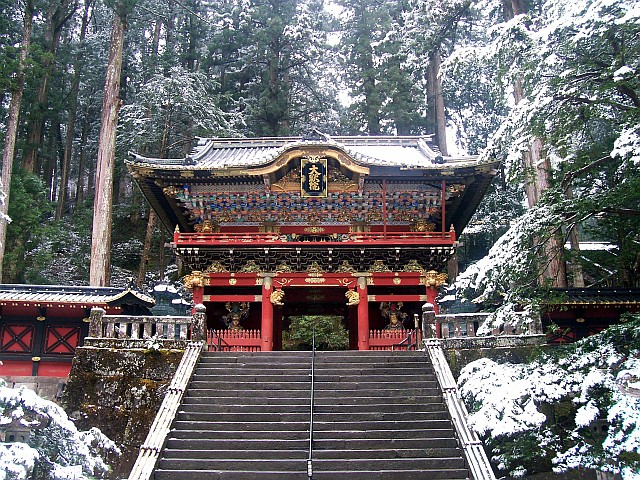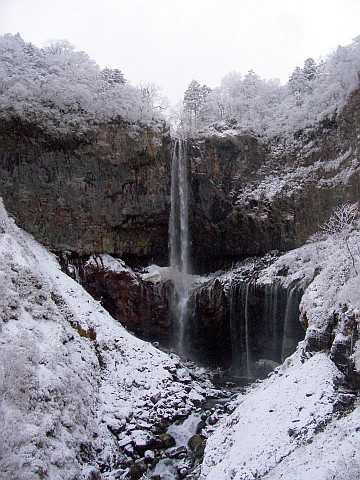COMING SOON HOUSE ADVERTISING ads_leader
Published: January 19th 2011
A day in Nikko
Nikko is a nice outing for a day in moutains and forests outside Tokyo.
The Shinto-Buddhist temples are in a particular style called gongen-zukuri, and they are sublime. I was lucky during my trip because the snow had just fallen and it created a kind of magic in scenery already beautiful. In addition to visiting the temples we can extend the visit by going to Chuzenji lake and Kegon Falls (by bus, with a winding and beautiful road). And note that Nikko means "sunlight".
Let's cross Shinkyo sacred bridge...

Tosho-gu shrine
It is the mausoleum of the first shogun of the dynasty Tokugawa : Tokugawa Ieyasu who completed the unification of Japan under his authority and moved the shogunate in Edo (Tokyo)... He asked to be buried at his death in Nikko in order to protect Edo from invisible enemies supposedly coming from the north. Like any Shinto shrine we enter through a torii.
On a first gate, there are sculptures of two guardians ni-oh, one with the mouth open pronounces the sound "ah" (beginning) while the second, with the mouth closed pronounces the sound "um" (the end). Buddhism derives for some of its roots from Hinduism (by syncretism) in which the sound "Aum" is the sound of creation of the world emerging from chaos. On a next door was the Komas (half-dog, half-lion) who are also guardians.
See also the 5-storey pagoda, the sacred stable with a woodcarving of the three wise monkeys, from Chinese mythology. The wisdom of the three monkeys is : "not hear what I should not hear", "not say that I should not say", "not see what I should not see". Their names are : Kikazaru, Iwazaru and Mizaru. Thus they represent the three most important principles of the Japanese Tendai Buddhist sect, found here by syncretism. Note : the Indian Gandhi always carried with him an engraving of this three monkeys...

Yomeimon gate is wonderful !
Taiyuin-byo shrine
It is the mausoleum of the famous shogun Tokugawa Iemitsu (1603-1661) who closed Japan to the world (this closed period lasted more than two centuries and is called sakoku). He was the grand-son of the first shogun of the dynasty Tokugawa : Tokugawa Ieyasu. He first ordered the Tosho-gu shrine for his grandfather and then Taiyuin-byo for himself.
The term shogun refers to a title of commander in chief with the power of governing the country by delegation of the emperor (dairi). Initially, this title was granted by the emperor during wars and was temporary. But in 1192, the samurai Minamoto-no-Yoritomo noticing the weakness of the emperor took the title of shogun to run the country. He kept the emperor in Kyoto but established a military power in Kamakura. This was that military power which then really ruled Japan and shogunate became the official political system that year 1192. Though marked by several succession wars, the period of shogunate lasted until 1867 when Meiji emperor took over (it is called the Meiji restoration or Meiji Ishin).
In the 16th century, leaders Nobunaga Oda and Toyotomi Hideyoshi began the unification of Japan on their behalf. It is also during this century that the Portuguese came in Japan and brought Christian religion. Hideyoshi promulgated the first ban of Christianity in 1587 and expelled the Jesuits. He died in 1598 leaving his clan weakened after failing the invasion of Korea and a war of succession ensued. It was finally Tokugawa Ieyasu (1543-1616) who won the decisive battle of Sekigahara (the battle that decided the fate of the nation) in 1600. He took the title of shogun and completed the unification of Japan.
The Shogun Tokugawa Iemitsu (1604-1651), grand-son of the former one is the shogun under which Japan was closed on itself. He first turned against Japanese Christians, mostly present around Nagasaki, by persecuting them and crushing the rebellion of Shimabara. He then banned trade with the Portuguese (who opened a trade route between Macao and Japan) under penalty of death. He criticized them for having brought the Christian faith in Japan. Only Chinese and Dutch could still trade with Japan, but it remained highly regulated. On the other hand, the refinement of Nikko shrines (mausoleums for himself and his grandfather) is due to this shogun.

Nitenmon gate marking the entrance of the shrine is superb ! You can also see several statues of deities and guardians.
Chuzenji lake and Kegon falls
It is also a great complement to the visit of the temples 30 km (18.6 miles) away from Nikko. It takes 50 min by bus. The road is beautiful, and how convenient : lake Chuzenji and Kegon Falls, a 97 m (318 feet) waterfalls, are nearby. We can also stop a few stops earlier to get to a viewpoint (which was closed because of too much snow on the day of my visit).

Hope you've enjoyed this...
COMING SOON HOUSE ADVERTISING ads_leader_blog_bottom
Tot: 0.063s; Tpl: 0.008s; cc: 7; qc: 49; dbt: 0.0307s; 1; m:domysql w:travelblog (10.17.0.13); sld: 1;
; mem: 1.1mb



